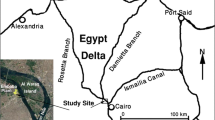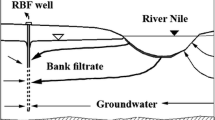Abstract
Riverbank filtration (RBF) schemes based on the filtration of the river water through adjacent aquifers have been successfully implemented in the plains globally. In the mountainous regions, alluvial aquifers are generally narrow and restricted to the riverbanks. The present study assesses the possibility and potential of RBF in the lower Himalayan region for drinking water supply. Production wells (18–30 m deep) were commissioned on the banks of the rivers (1) Alaknanda in Srinagar (546 m a.m.s.l.) and Kaleshwar (Karnaprayag; 778 m a.m.s.l.); (2) East Nayar in Satpuli (576 m a.m.s.l.) and (3) Mandakini in Agastyamuni (783 m a.m.s.l.) in Uttarakhand, India. Waters from the rivers, production wells, and hand pumps were analyzed for major ions, coliforms and stable isotopes (δ18O and δ2H). The wells delivered coliform- and turbidity-free water even during monsoon. The proportion of the bank filtrate was site specific and also varied from monsoon to non-monsoon periods. The Satpuli scheme draws almost completely bank filtrate round the year. The other three schemes substantially draw groundwater and its proportion increases in monsoon. In Srinagar, the well water was chemically similar to the ground water but isotopically similar to the river water. The region also has a complex hydrology with paths that deliver river water containing coliforms and even suspended silt up to ~ 0.5 km inland. A severe flooding event during the study period affected the RBF sites in Srinagar and Kaleshwar, thereby indicating the need to make RBF wells flood proof. In general, the study shows RBF to be an effective and sustainable option to supply drinking water in a few regions of lower Himalayas.








Similar content being viewed by others
References
Andermann C, Bonnet S, Crave A, Davy P, Longuevergne L, Gloaguen R (2012) Sediment transfer and the hydrological cycle of Himalayan rivers in Nepal. CR Geosci 344:627–635
APHA, AWWA, WEF (2005) Standard methods for the examination of water and wastewater. 21st edn, American Public Health Association, Washington, DC
Cady P, Boving TB, Choudri BS, Cording A, Patil K, Reddy V (2013) Attenuation of bacteria at riverbank filtration site in rural India. Water Environ Res 85(11):2164–2174
Caldwell TG (2006) Presentation of data for factors significant to yield from several riverbank filtration systems in the U.S. and Europe. In: Hubbs SA (ed) Riverbank filtration hydrology. Springer, Dordrecht
Census of India (2011) publication of office of the registrar general and census commissioner, India. http://www.censusindia.gov.in. Accessed 7 April 2015
CGWB (2011a) Groundwater brochure of Chamoli District, Uttarakhand. http://cgwb.gov.in/District_Profile/Uttarakhand/Chamoli.pdf. Accessed 20 Mar 2015
CGWB (2011b) Groundwater brochure of Rudraprayag District, Uttarakhand. http://cgwb.gov.in/District_Profile/Uttarakhand/RUDRAPRAYAG.pdf. Accessed 17 Jan 2015
Chakrapani GJ, Saini RK (2009) Temporal and spatial variations in water discharge and sediment load in Alaknanda and Bhagirathi Rivers in Himalaya, India. J Asian Earth Sci 35:545–553
Dash RR, Mehrotra I, Kumar P, Grischek T (2008) Lake bank filtration at Nainital, India: water-quality evaluation. Hydrogeol J 16(6):1089–1099
Dash RR, Prakash EVPB., Kumar P, Mehrotra I, Sandhu C, Grischek T (2010) River bank filtration in Haridwar, India: removal of turbidity, organics and bacteria. Hydrogeol J 18(4):973–983
Dillon P, Jiménez B (2008) Water reuse via aquifer recharge: intentional and unintentional practices. In: Jiméne B, Asano T (eds) An international survey of current practice, issues and needs. IWA Publishing, London, pp 260–280
Dupuit J (1863) Etudes theoriqueset pratiquessur le mouvement des eaux dans les canaux decouvert set a travers les terrains permeables. 2nd edn; Dunot Paris, 304 p. In Kruseman GP, de Ridder NA (1973) Analysis and evaluation of pumping test data. Int Institute for Land Reclamation and Improvement, Wageningen, ISBN 3-481-14811-9
Eckert P, Irmscher R (2006) Over 130 years of experience with Riverbank Filtration in Dusseldorf, Germany. Aqua 55:283–291
GoogleMaps (2014) http://maps.google.com/. Accessed 1 Oct 2014
Grischek T, Bartak R (2016) Riverbed clogging and sustainability of riverbank filtration. Water 8(12):604:1–12. https://doi.org/10.3390/w8120604
Grischek T, Ray C (2009) Bank filtration as managed surface-groundwater interaction. Int J Water 5(2):125–139. https://doi.org/10.1504/IJW.2009.028722
Grischek T, Nestler W, Dehnert J, Neitzel P (1994) Groundwater/river interaction in the Elbe river basin in Saxony. In: Stanford JA, Vallett HM (eds) Ground water ecology. American Water Resources Association, Herndon, Virginia, pp 309–318
Grischek T, Schoenheinz D, Worch E, Hiscock K (2002) Bank filtration in Europe—an overview of aquifer conditions and hydraulic controls. In: Dillon P (ed) Management of aquifer recharge for sustainability. Balkema Publ., Swets & Zeitlinger, Lisse, pp 485–488
Gupta S (2014) Ground Water Scenario of Himalayan Region, India. Central Ground Water Board, Ministry of Water Resources, Government of India, Faridabad
Gupta A, Ronghang M, Kumar P, Mehrotra I, Kumar S, Grischek T, Sandhu C, Knoeller K (2015a) Nitrate contamination of riverbank filtrate at Srinagar, Uttarakhand, India: a case of geogenic mineralization. J Hydrol 531:626–637
Gupta A, Singh H, Ahmed F, Mehrotra I, Kumar P, Kumar S, Grischek T, Sandhu C (2015b) Lake bank filtration in landslide debris: irregular hydrology with effective filtration. Sustain Water Resour Manag 1(1):15–26
Heeger D (1987) Investigations on clogging of river beds. Doctoral Dissertation, Division of Water Sciences, TU Dresden
Hubbs SA (2006) Evaluating streambed forces impacting the capacity of riverbed filtration systems. In: Hubbs SA (ed) Riverbank filtration hydrology. Springer, Dordrecht
IS:10500 (2012) Indian standard: drinking water specifications. Publication of Bureau of Indian Standards, New Delhi
Kimothi PC, Dimri DD, Adlakha LK, Kumar S, Rawat OP, Patwal PS, Grischek T, Sandhu C, Ebermann J, Ruppert M, Dobhal R, Ronghang M, Kumar P, Mehrotra I, Uniyal HP (2012) Development of riverbank filtration in Uttarakhand. J Indian Water Works Assoc 2012:13–18
Kuehn W, Mueller U (2002) Riverbank filtration: an overview. J AWWA 92(12):60–69
Kumar B, Rai SP, Kumar US, Verma SK, Garg P, Vijaya Kumar SV, Jaiswal R, Purendra BK, Kumar SR, Pande NG (2010) Isotopic characteristic of Indian precipitation. Wat Res Res 46:W12548
Kumar P, Mehrotra I, Boernick H, Schmalz V, Worch E, Schmidt W, Grischek T (2012) Riverbank filtration: an alternative to pre-chlorination. J Indian Water Works Association, Special Issue, December 2012, pp 50–58
Kumari S (2015) Organic micropollutants in the River Yamuna and Ranny Wells in Central Delhi. Ph.D. thesis, Dept. of Civil Eng., Indian Institute of Technology Roorkee, Roorkee, India
Lee SI, Lee SS (2009) Site suitability analysis for riverbank filtration in the Han River, Korea. In Zhang C, Tang H (eds) Advances in water resources and hydraulic engineering. In: Proc 16th IAHR-APD Congress and 3rd Symp of IAHR-ISHS, Springer, pp 236–239
Lorenzen G, Sprenger C, Taute T, Pekdeger A, Mittal A, Massmann G (2010) Assessemnt of the potential for bank filtration in a water-stressed megacity (Delhi, India). Env Earth Sci 61(7):1419–1434
Maithani JBP (1972) Geology of South-Western Garhwal. Progress Report for the field season 1971–1972, Geological Survey of India, Northern Region, Lucknow http://www.portal.gsi.gov.in/gsiDoc/fspReports/NRO/1970-1975/NRO_07832_1971_1972_REPORT_1.pdf
Panwar S, Chakrapani GJ (2016) Seasonal variability of grain size, weathering intensity, and provenance of channel sediments in the Alaknanda River Basin, an upstream of river Ganga. India Environ Earth Sci 75:998
Ray C (2008) Worldwide potential of riverbank filtration. Clean Technol Environ Policy 10(3):223–225
Ray C, Grischek T, Schubert J, Wang JZ, Speth TF (2002) A perspective of riverbank filtration. J AWWA 94(4):149–160
Ray C, Melin G, Linsky RB (2003) Riverbank filtration: improving source-water quality. Kluwer Academic Publishers, Dordrecht
Ray C, Jasperse J, Grischek T (2011) Bank filtration as natural filtration. In Ray C, Jain R (eds) Drinking water treatment, focusing on appropriate technology and sustainability. Springer Dordrecht, pp 93–158
Saini B, Mehrotra I, Kumar P, Verma R (2013) Insight of riverbank filtration system at Haridwar for enhancement of drinking water quality. Int J Curr Eng Technol 3(4):1264–1270
Sandhu C, Grischek T, Kumar P, Ray C (2011) Potential for riverbank filtration in India. Clean Technol Environ Policy 13(2):295–316
Sandhu C, Grischek T, Musche F, Macheleidt W, Heisler A, Handschak J, Patwal PS, Kimothi PC (2017) Measures to mitigate direct flood-risks at riverbank filtration sites with a focus on India. Sustain Water Resour Manag. https://doi.org/10.1007/s40899-017-0146-z
Schubert J (2002) Hydraulic aspects of riverbank filtration—field studies. J Hydrol 266(3):145–161
Semwal N, Akolkar P (2006) Water quality assessment of sacred Himalayan rivers of Uttaranchal. Curr Sci 91(4):486–496
Singh P, Kumar P, Mehrotra I, Grischek T (2010) Impact of Riverbank Filtration on Treatment of Polluted River Water. J Environ Manag 91(5):1055–1062
Sprenger C, Lorenzen G, Grunert A, Ronghang M, Dizer H, Selinka HC, Szewzyk R (2014) Removal of indigenous coliphages and enteric viruses during riverbank filtration from highly polluted river water in Delhi (India). J Water Health 12(2):332–342
Sprenger C, Hartog N, Hernández M, Vilanova E, Grützmacher G, Scheibler F, Hannappel S (2017) Inventory of managed aquifer recharge sites in Europe: historical development, current situation and perspectives. Hydrogeol J 25:1909–1922
Thiem G (1906) Hydrologische Methoden. Gebhardt, Leipzig, 56. In Kruseman GP, de Ridder NA (1973) Analysis and evaluation of pumping test data. Int Institute for Land Reclamation and Improvement, Wageningen. ISBN 3-481-148119
Acknowledgements
These investigations were primarily conducted within the framework of the project, titled “Development of Riverbank Filtration in Hill Regions of Uttarakhand for Sustainable Quality and Quantity of Drinking Water”, that commenced in March 2010 and was funded by the ‘Water Technology Initiative’ of the Department of Science and Technology, Government of India. The wells were drilled under the supervision of the Uttarakhand State Water Supply Organisation—Uttarakhand Jal Sansthan (UJS). The logistic and technical support of UJS, especially Mr. P.C. Kimothi as principal investigator and Mr. L.K. Adlakha as co-investigator of the project, are gratefully acknowledged. The assistance and services of the Uttarakhand State Council for Science and Technology as coordinator, especially Dr. R.R. Dobhal and Dr. D.P. Uniyal, the Cooperation Centre for Riverbank Filtration as a partner and Mr. Arun Gulati of the well-drilling company Akshay Jaldhara is appreciated. The authors are also grateful to the project ‘Riverbank Filtration Network (BMBF IND 08/156)’ funded within the program ‘India and Germany – Strategic Partners for Innovation’ of the German Federal Ministry of Education and Research and the “Sustainable Urban Water Management” (project no. 50016952) funded within the program ‘A New Passage to India (2009–2014)’ of the German Academic Exchange Service (DAAD) for supporting the mobility to conduct the scientific work. Special thanks are due to J. Ebermann and M. Ruppert for accompanying the well-drilling activities, conducting the sieve analysis and preparing the original borehole profiles, and P. Bahner, T. Wohlgemuth, F. Musche and E. Ballmann for assisting with the pumping tests.
Author information
Authors and Affiliations
Corresponding author
Rights and permissions
About this article
Cite this article
Ronghang, M., Gupta, A., Mehrotra, I. et al. Riverbank filtration: a case study of four sites in the hilly regions of Uttarakhand, India. Sustain. Water Resour. Manag. 5, 831–845 (2019). https://doi.org/10.1007/s40899-018-0255-3
Received:
Accepted:
Published:
Issue Date:
DOI: https://doi.org/10.1007/s40899-018-0255-3




